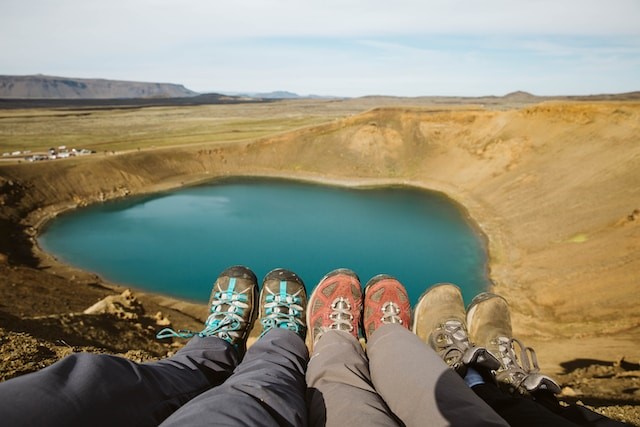Footwear Unleashed: Exploring the Top Hiking Shoes to Conquer Nature's Trails
Step into the world of outdoor
exploration with the perfect pair of hiking shoes. As nature beckons, you need
footwear to keep pace with the rugged terrain. From rocky trails to dense
forests, the top hiking shoes are designed to conquer it all, providing the
comfort, support, and durability essential for the journey ahead. In this
comprehensive guide, we unveil the ultimate hiking shoes that blend performance
with style, ensuring you conquer nature's trails and do so in unparalleled
comfort and confidence.
Whether you're an avid hiker, an
occasional trekker, or a passionate nature lover, finding the right pair of
shoes for your
hiking trip is a game-changer, shaping your outdoor experience from start
to finish. Let's delve into the world of trail-ready footwear, where each step
brings you closer to the extraordinary adventure that awaits.
The Importance of Choosing the Right Hiking
Shoes
Choosing the right hiking shoes is
crucial for any outdoor adventure. The right pair can distinguish between a
comfortable, enjoyable hike and a painful, exhausting experience. Hiking shoes
provide stability, support, and protection for your feet, enabling you to navigate
challenging terrain easily. They also help prevent injuries such as twisted
ankles and blisters, allowing you to focus on the beauty of your surroundings
rather than discomfort.
When selecting hiking shoes, it's
essential to consider factors such as fit, support, traction, and waterproofing
to ensure they meet the demands of your chosen trails. Investing in great
hiking shoes, such as the ones from Dwight’s Outdoors, is
an investment in your overall hiking experience, enhancing your comfort and/or
performance while minimizing the risk of foot-related issues.
Types of Hiking Shoes
Hiking shoes come in
various types, each catering to specific hiking needs and terrains. Low-cut
hiking shoes are lightweight and flexible, making them suitable for day hikes
and less demanding trails. They offer a balance of support and comfort, ideal
for those seeking agility and speed. Mid-cut hiking shoes provide additional
ankle support, making them suitable for more challenging terrains and longer
hikes.
They offer increased stability and
protection, making them a popular choice for intermediate hikers. High-cut
hiking boots provide maximum ankle support and protection, making them the
go-to choice for rugged, off-trail adventures and multi-day treks. They provide
stability and insulation, ensuring your feet remain secure and comfortable in
harsh conditions. Understanding the different types of hiking shoes allows you
to select the most suitable based on your hiking style and the terrain you plan
to conquer.
Key Features to Consider When Choosing
Hiking Shoes
When choosing hiking shoes, several
key features should guide your selection process. The fit is paramount; hiking
shoes should provide a snug yet comfortable feel without causing pressure
points or rubbing. Look for shoes with ample toe room to prevent blisters and
ensure your toes have space to move naturally. Support and stability are crucial,
especially for challenging terrains.
Opt for shoes with sturdy,
well-cushioned soles and ankle support to considerably minimize the risk of
injuries. Traction is essential for navigating varied terrain, so select shoes
with aggressive, multidirectional lugs for superior grip. Waterproofing
is vital for wet conditions, ensuring your feet remain dry and comfortable.
Breathability is essential to prevent
sweat buildup and discomfort, especially in warmer climates. Lastly, consider
the weight of the shoes, opting for a balance between durability and
lightweight design for optimal performance. By prioritizing these key features,
you can ensure your hiking shoes are equipped to handle the demands of nature's
trails.
Hiking Shoes for Different Weather
Conditions
Nature's trails can present a range of
weather conditions, from scorching heat to torrential downpours, necessitating
the need for versatile hiking shoes. For hot and dry climates, breathable
hiking shoes with moisture-wicking properties are essential to prevent
overheating and discomfort.
Look for shoes with mesh uppers and
ventilated designs to promote airflow and keep your feet cool. In contrast, for
wet and muddy conditions, waterproof hiking shoes with sealed seams and
protective toe caps are crucial for keeping your feet dry and shielded from the
elements.
Additionally, shoes with quick-drying
materials and water-draining features are advantageous for traversing streams and
encountering unexpected rainfall. Insulated hiking shoes are ideal for cold
climates, providing warmth and protection from freezing temperatures. By
selecting hiking shoes that cater to various weather conditions, you can ensure
your feet remain comfortable and supported throughout your outdoor endeavors.
How to Care for and Maintain Your Hiking
Shoes
Proper care and/or maintenance are
essential for prolonging the lifespan and performance of your hiking shoes.
After each hike, remove dirt, mud, and debris from your shoes employing a soft
brush or damp cloth. This prevents the accumulation of grime, which can degrade
the materials and compromise the shoe's integrity.
Allow your shoes to air dry naturally;
that way, avoid direct heat sources such as radiators or sunlight, which can
cause the materials to deteriorate. Regularly apply a waterproofing treatment
to maintain the shoe's water repellency and protect it from moisture. Inspect
the shoe's laces, insoles, and outsoles for signs of wear and tear, replacing
any components showing excessive damage to ensure the shoe remains structurally
sound.
Proper storage is also crucial, as
storing your hiking shoes in a cool, dry place away from direct sunlight helps
preserve their materials and shape. By implementing these care practices, you
can extend the longevity of your hiking shoes and sustain their performance on
the trails.
Expert Tips for Breaking in New Hiking
Shoes
Breaking
in new hiking shoes is essential to prevent discomfort and blisters during
your adventures. Start by wearing your brand-new shoes around the house for
short periods to allow them to conform to your foot shape gradually. Gradually
increase the overall duration and/or intensity of wear, wearing them on short
walks and easy hikes to accustom your feet to the shoes' fit and support.
Use high-quality hiking socks to
ensure a comfortable, blister-free experience, as well-fitting socks can
complement the fit of your hiking shoes. Pay attention to any discomfort or
pressure points, using techniques such as lacing adjustments and cushioning
inserts to alleviate any issues.
Being patient during the break-in
process is essential, allowing your feet and the shoes to adapt gradually for
optimal comfort and performance. By following all these expert tips, you can
ensure your new hiking shoes are primed and ready for the trails, providing the
support and comfort you need for a successful outdoor experience.






Comments
Post a Comment